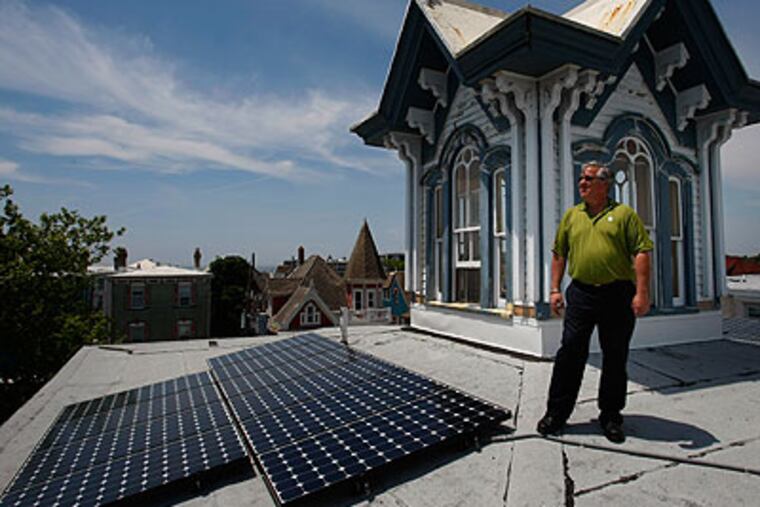Historic Cape May allows newfangled alteration
CAPE MAY - Thirty-eight new solar panels are hidden from sight atop the ornate 1882 Italianate structure that houses the Mad Batter Restaurant and Carroll Villa Hotel in the historical heart of this 19th-century seaside town.

CAPE MAY - Thirty-eight new solar panels are hidden from sight atop the ornate 1882 Italianate structure that houses the Mad Batter Restaurant and Carroll Villa Hotel in the historical heart of this 19th-century seaside town.
And the Cape May Historic Preservation Commission, watchdog of all things authentic and historically accurate, very much likes it that way. It has consistently eschewed the installation of anything made of vinyl on the town's architectural jewels.
For 34 years, Cape May has been designated a National Historic Landmark city, containing more historically significant structures with the fanciful, curlicue, wooden "gingerbread" facades from the Victorian era than any other place in the United States outside San Francisco. Cape May also is recognized as the country's oldest beach resort.
So when his application to install the solar panels was approved by the venerable commission - an agency that recently decried energy-generating wind turbines inside the town's historic zone - Mark Kulkowitz was ecstatic.
"This was something we really wanted to do for a long time," said Kulkowitz, whose family has owned the Jackson Street hotel and restaurant since 1976. "And something that took a lot of planning to accomplish."
Kulkowitz, who operates the establishment with his wife, Pam Huber, said the "go green" concept had been at the forefront of a major renovation the last several years. They switched to an industrial dishwasher that is supposed to save 100,000 gallons of water a year, energy-efficient lightbulbs and showerheads in all the guest rooms, linen-free tabletops in the restaurant, and earth-friendly, clay-based wall and ceiling colors instead of commercial paints containing volatile chemicals.
And they have used various "found" materials and antiques to decorate the rooms.
But the solar panels, installed on two flat sections of the roof and visible only four stories up from the widow's walk cupola, were the final piece of Kulkowitz's environmental plan.
The panels won't generate enough energy to fully operate the business, much less create a surplus to sell back into the energy grid, but it's a start, he said.
Installed by Mercury Solar Systems of Mays Landing, the panels will provide 10,293 kilowatt hours a year.
That will offset about 7,987 pounds of carbon dioxide - an amount equivalent to recycling 165,000 soda cans, or not burning 962 gallons of gasoline, or planting one acre of trees, according to Matt Elliott, a clean-energy advocate for Environment New Jersey.
"We're thrilled to see another New Jersey business plug into the sun," said Elliott, a spokesman for the statewide environmental advocacy organization. "Solar is truly a 21st-century clean-energy technology. We congratulate [them] for jumping on board."
Tom Carroll, a member of the Cape May Historic Preservation Commission, said "jumping" should be done with caution in Cape May's preservation district.
He said the commission, notorious for turning down homeowners' requests to replace salt-air-ravaged wooden siding and window frames with vinyl and other materials, allowed Kulkowitz's project and a few smaller homeowner solar projects with "much thought and consideration."
"I think moving in this direction needs to be done, but it needs to be done at a reasonable pace and very carefully," Carroll said. "I'd hate to see us sacrifice our historic district for the sake of new technologies."
In the future, he predicted, preservation agencies like Cape May's will be more open to new technologies when they are developed to "minimize the visual effect."
Donovan Rypkema, an expert in economics of historic preservation, agreed.
"I'm for projects such as these when they can be done discreetly and sensibly," said Rypkema, a principal in the Washington firms Place Economics and Heritage Strategies, who addressed the National Trust for Historic Preservation recently on making preservation relevant over the next 50 years.
"But the historic-preservation community needs to demand from these new technology companies that they create products that do not compromise the historical integrity of these buildings," Rypkema said. "We can't buy into the argument that saving energy is more important than historical integrity."